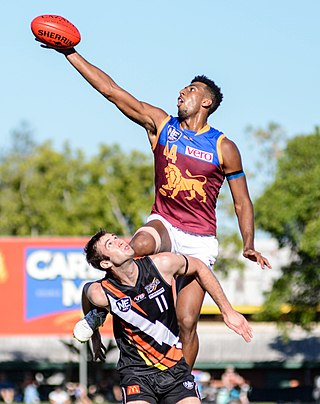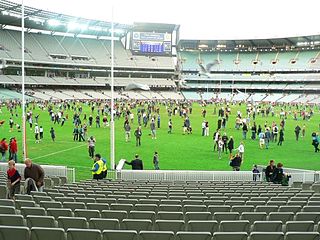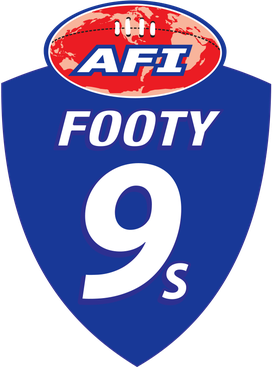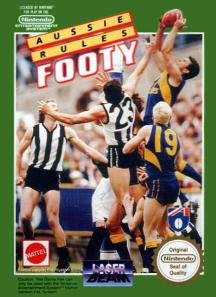
Australian rules football, also called Australian football or Aussie rules, or more simply football or footy, is a contact sport played between two teams of 18 players on an oval field, often a modified cricket ground. Points are scored by kicking the oval ball between the central goal posts, or between a central and outer post.

International rules football is a team sport consisting of a hybrid of football codes, which was developed to facilitate international representative matches between Australian rules football players and Gaelic football players.

Jeffrey Newman "Jeff" White is an Australian rules footballer who had a distinguished career in the Australian Football League (AFL) spanning 14 years. He played most recently and notably for the Melbourne Football Club, following a move from the Fremantle Dockers at the end of 1997. He was Melbourne's first-choice ruckman for a decade, relying on his key attributes of athleticism and durability. He was an All-Australian in 2004, and was selected for Victoria several times. He was an important member of the Melbourne sides which made the 2000 AFL Grand Final and qualified for six finals series from 1998 to 2006.
Anthony William Brownless is a former Australian rules footballer and radio and television media personality who represented Geelong in the Australian Football League (AFL) during the 1980s and 1990s.

The punt kick is a common style of kicking in Australian rules football. It is a kick where the ball is dropped from the players' hands and kicked slightly off the longer centre line of the ball before it hits the ground. It is the primary means of kicking the ball in Australian football and is similar to punts used tactically in other football codes, such as American and Canadian football.

Recreational Football was a non-contact version of the Australian rules football game first played in 2003 and later sanctioned by the Australian Football League's game development arm, it was inspired heavily by the growing popularity of tag rugby. It was a more accessible version of Australian rules football that people could pick up and play. It was a mixed competition, with eight players on each team, accessible to players of both sexes, all shapes and sizes and requires minimal equipment to play. Rec Footy was criticised mainly by Australian rules players for appearing similar to netball and being too restrictive, lacking of ability for skilled footballers to run kick and play naturally whilst also penalising newer unskilled players with frequent turnovers.

The laws of Australian rules football were first defined by the Melbourne Football Club in 1859 and have been amended over the years as Australian rules football evolved into its modern form. The Australian Football Council (AFC), was formed in 1905 and became responsible for the laws, although individual leagues retained a wide discretion to vary them. Following the restructure of the Victorian Football League's competition as a national competition and the League's renaming to be the Australian Football League (AFL), since 1994, the rules for the game have been maintained by the AFL through its Commission and its Competition Committee.

In Australian rules football, a ruck, or ruckman/ruckwoman, is typically a tall and athletic player who contests at centre bounces and stoppages. The ruck is one of the most important players on the field. They are often key to coaching strategy and winning centre clearances which result in the most goal kicking opportunities.
Nine-a-side football is a sport based on Australian rules football played informally by Aussie rules clubs but not yet an official sport in its own right.

A free kick in Australian rules football is a penalty awarded by a field umpire to a player who has been infringed by an opponent or is the nearest player to a player from the opposite team who has broken a rule.

International Cricket is a cricket video game for the Nintendo Entertainment System. It was developed by Melbourne based Beam Software and published under their Laser Beam Entertainment publishing arm in 1992. Aussie Rules Footy shares the same presentation style as this game. Like Aussie Rules Footy, the game was distributed exclusively by Mattel's Australian operation.

Kick-to-kick is a pastime and well-known tradition of Australian rules football fans, and a recognised Australian term for kick and catch type games. It is a casual version of Australian rules.

A ball-up in Australian rules football is the method by which the field umpire restarts play at a neutral contest after a stoppage within the field of play. It involves the throwing or bouncing of the ball up between two players, known as rucks, who then attempt to win possession for their teams.
Australian rules football in Samoa has been played since 1997.

Australian rules football and Gaelic football are codes of football, from Australia and Ireland respectively, which have similar styles and features of play. Notably both are dominated by kicking from the hand and hand passing as well as rules requiring the ball is bounced by a player running in possession, both have a differentiated scoring system, with higher and lower points values for different scoring shots, both have no offside rule, and both allow more physical contact and players on the field than other football codes - 15 in gaelic football, 18 in Australian Rules.
Variations of Australian rules football are games or activities based on or similar to the game of Australian rules football, in which the player uses common Australian rules football skills. They range in player numbers from 2 up to the minimum 38 required for a full Australian rules football.

This list is an alphabetical glossary of Australian rules football terms, jargon and slang. While some of these entries are shared with other sports, Australian rules football has developed a unique and rich terminology.
There are various individual skills and team tactics that are required to play Australian rules football effectively. These are dictated by tradition and the sport's laws.

Footy 9s is a version of Australian rules football created by Australian Football International.
Nicholas Murray is an Australian rules footballer playing for the Adelaide Football Club in the Australian Football League (AFL). As a junior, Murray played for the Murray Bushrangers and the Greater Western Sydney Giants' reserves team. He was overlooked at the AFL draft for two seasons in a row before being signed to a rookie contract with Adelaide in early 2021 and making his AFL debut less than three weeks later. Murray has since become an integral part of Adelaide's backline.














